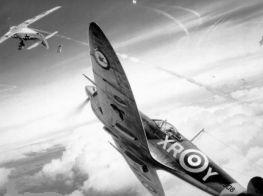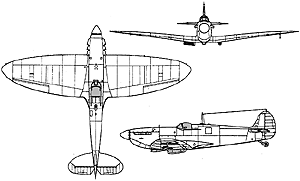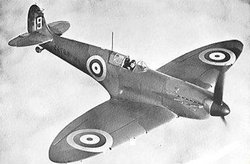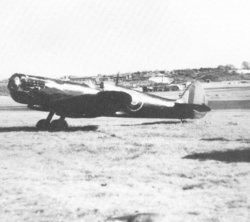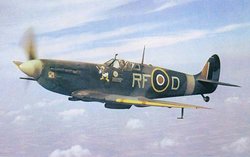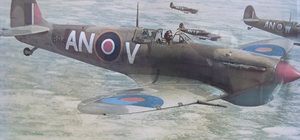|
|||||||||||||||||||||||||||||||||||||||||||||||||||||||||||||||||||||||||||||||||||||||||||||
|
The Supermarine Spitfire was a single seat fighter used by the RAF and many Allied countries in World War II. The Spitfire's elliptical wings gave it a very distinctive look; their thin cross-section gave it speed; the brilliant design of Chief Designer R.J. Mitchell and his successors (he died in 1937) meant the Spitfire was loved by its pilots. It saw service during the whole of World War II, in all theatres of war, and in many different variants.
More than 20,300 of all variants were built, and Spitfires remained in service well into the 1950s. The aircraft was coined Spitfire by Sir Robert MacLean, director of Vickers at the time and on hearing this, Mitchell is reported to have said "...sort of bloody silly name they would give it." The word dates from Elizabethan times and refers to a particularly fiery, ferocious type of person, usually a woman. The name had previously been used unofficially for Mitchell's earlier F.7/30 Type 224 design.
Supermarine Spitfire 1 in action
Design
Supermarine Chief Designer R.J. Mitchell had won three Schneider Trophy seaplane races with his aircraft, by combining powerful Napier or Rolls Royce engines with minute attention to streamlining. These same qualities are equally useful for a fighter design, and in 1930 Mitchell produced such a plane in response to an Air Ministry request for a new and modern monoplane fighter. This first attempt at a fighter resulted in an open-cockpit monoplane with gull-wings and a large fixed spatted undercarriage. The Supermarine Type 224 did not live up to expectations; nor did any of the competing designs which were also deemed failures.
Mitchell immediately turned his attention to an improved design as a private venture, with the backing of Supermarine owners Vickers. The new design added gear retraction, an enclosed cockpit, oxygen gear, and the much more powerful Rolls Royce PV-12 engine.
By 1935 the Air Ministry had seen enough advancement in the industry to try the monoplane design again. They eventually rejected the new Supermarine design on the grounds that it did not carry the required eight-gun load, and didn't appear to have room to do so.
Once again Mitchell was able to solve the problem. It has been suggested that by looking at various Heinkel planes he settled on the use of an elliptical planform, which had much more chord to allow for the required eight-guns, while still having the low drag of the earlier, simpler wing design. Mitchell's aerodynamicist, Beverley Shenstone, however, has pointed out that Mitchell's wing was not directly copied from the Heinkel He 70, as some have claimed; the Spitfire wing was much thinner and had a completely different section. In any event, the elliptical wing was enough to sell the Air Ministry on this new Type 300, which they funded as F.10/35.
A feature of the final Spitfire design that has often been singled out by pilots is its washout feature, which was unusual at the time. The incidence of the wing is +2° at its root and -½° at its tip. This twist means that the wing roots will stall before the tips, reducing the potentially dangerous rolling moment in the stall known as a spin. Many pilots have benefitted from this feature in combat when doing tight turns close to the aircraft's limits.
Spitfire - plan and elevations
HISTORY
The prototype first flew on March 5, 1936. Performance was such that the Air Ministry immediately placed an order for 310 just three months later. At the time it was still being "shaken out" by Vickers test pilots, even before the aircraft had been handed to them for their own flight testing.
The following year the ministry ordered a further 200 planes shortly before the tragic death of its designer at the age of 42. In April 1938 the Nuffield Organisation was awarded an order for 1,000 Spitfires to be built at a shadow plant planned for Castle Bromwich near Birmingham, and further orders in 1939 brought the number of aircraft on the order book to a total of 2,143 by the outbreak of war.
Between August and December 1938 No. 19 Squadron at Duxford was equipped with the Spitfire Mk.1. By the outbreak of war nine squadrons were fully equipped and two others were in the process of conversion. A total of 1,583 Spitfire Is were built. Deliveries of the Mk. II (basically a Mk. I powered by a 1,175-h.p. Merlin XII) began in June 1940, but widespread re-equipment with the new version did not commence until the following winter, and it was the Mk. 1 which bore the brunt of the fighting during the Battle of Britain; by July 7th nineteen Fighter Command Squadrons were operational with the type. The Spitfire has always attracted more attention than the Hurricane, and is undoubtedly one of the most famous aircraft ever built. Its graceful lines combined with outstanding handling qualities to produce a "dream plane" extremely fast, and in comparison to contemporary types was second to none.
Battle of Britian | Calendar | Aircraft | Links | Commanders
Variants
There were 24 marks of Spitfire and many sub-variants. For a brief history of the Spitfire's development over time see Supermarine Spitfire variants.
Naval version
Supermarine Spitfire in flight
There also was a naval version of the Spitfire called the Seafire. It was especially adapted for operation from aircraft carriers: with an arrester hook, folding wings and other specialised equipment. However, like the Spitfire, the Seafire had a narrow undercarriage track, which meant that it was not well suited to deck operations. Due to the addition of heavy carrier equipment, it suffered from an aft centre-of-gravity position that made low-speed control difficult, and its gradual stall characteristics meant that it was difficult to land accurately on the carrier. These characteristics resulted in a very high accident rate for the Seafire.
Compared with other naval fighters, the Seafire II was able to outperform the A6M5 (Zero) at low altitudes when the two types were tested against each other in WW2. Contemporary western carrier aircraft like the F6F Hellcat and the F4U Corsair, however, were considerably more powerful. Late-war Seafire marks equipped with the Griffon engines enjoyed a considerable increase of performance compared to their Merlin-engined predecessors. The name Seafire was arrived at by collapsing the longer name Sea Spitfire.
Battle of Britain
The Spitfire is often credited with winning the Battle of Britain, it was mass produced in Castle Bromwich, Birmingham and there now stands a large metal memorial on Spitfire Roundabout on Chester Road in the city. The aircraft, and Mitchell, were lauded in the (somewhat inaccurate) movie The First of the Few. It certainly must be considered one of the finest aircraft of the war and possibly the most beautiful. But how did it compare with the Hawker Hurricane (that the RAF used in greater numbers at that critical stage in 1940), or with its counterpart in the German Luftwaffe, the Messerschmitt_Bf_109? The Hurricane's guns were better suited to attacking bombers, but the close pattern of fire and slow speed made the Hurricane a bad choice for attacking the German fighter escorts. The Spitfire, on the other hand, was in most respects the close equal of the Me109 but had some attributes that helped "Spits" to win many "dog fights" most often quoted is maneuverability but good cockpit visibility was probably a greater factor. Nonetheless, seven in every ten German planes shot down during the Battle of Britain were victims of Hurricane pilots. The mini-series Piece of Cake depicted the life of a Spitfire squadron during this period.
Speed and altitude records
Mk. XI flown by Sqn. Ldr. Martindale on 27 April 1944 to 606 mph
Due to the high altitudes necessary for these dives, a fully feathering Rotol propeller was fitted to prevent overspeeding. During the spring of 1944, high speed diving trials were being performed at Farnborough to investigate the handling of aircraft near the sound barrier. Because it had the highest limiting Mach number of any aircraft at that time, a Spitfire XI was chosen to take part in these trials. It was during these trials that EN 409, flown by Squadron Leader Martindale, reached 606 mph (975 km/h) in a 45 degree dive. Unfortunately the aircraft could not cope with this speed and the propeller and reduction gear broke off. Martindale successfully glided the 20 miles (30 km) back to the airfield and landed safely.
"That any operational aircraft off the production line, cannons sprouting from its wings and warts and all, could readily be controlled at this speed when the early jet aircraft such as Meteors, Vampires, P-80s, etc could not, was certainly extraordinary" - Jeffrey Quill
Evaluation of the recorded flight data suggested that in the dive, he achieved a speed of 690 mph (1,110 km/h) or Mach 0.94, which would have been the highest speed ever reached by a propeller driven aircraft. Today it is generally believed that this speed figure is the result of inherent instrument errors and has to be considered unrealistic. Other operators
Spitfire from the 303 Kościuszko Squadron.
Apart from the RAF, Spitfires served with most of the Allied air forces in World War II, especially the Polish Air Force, Czechoslovak Air Force, Royal Canadian Air Force, Royal Australian Air Force, South African Air Force and Royal New Zealand Air Force. It was one of only a few foreign aircraft to see service with the United States Army Air Corps. Several European countries also operated Spitfires based in the UK, under the auspices of the RAF, including the Armée de l'Air as part of the Free French air force, the Forces Aériennes Françaises Libres (FAFL). (See Armée de l'Air (Part II).) In the Swedish Air Force the Spitfire was given the name S31 and it was in use up to 1955 when it was replaced by SAAB Tunnan.
Following World War II, the Spitfire remained in use with many air forces around the world, including the Egyptian Air Force, Hellenic Air Force, Irish Air Corps, Israeli Air Force, Syrian Air Force, Danish Air Force, Royal Norwegian Air Force and Turkish Air Force. Spitfires played a major role in the Greek Civil War, both flown by the RAF during 1944 and 1945, and by the Royal Hellenic Air Force from 1946 through the end of the war in 1948.
Spitfires last saw major action during the 1948 Arab-Israeli War, when — in a strange twist — Israeli Spitfires were engaged by both British and Egyptian Spitfires. Some air forces retained Spitfires in service until well into the 1960s, while some pilots who flew Spitfires in World War II were able to remain in service for decades; for example, Flight Lieutenant "Joe" Kmiecki, a Polish pilot who flew Spitfires during the war, did not retire from the RAF until 1981. Planes remaining in use
Many Spitfires and a few Seafires remain airworthy and many aircraft museums treasure static examples of this graceful yet lethal fighter. The RAF maintains some for flying display and ceremonial purposes in the Battle of Britain Memorial Flight at RAF Coningsby in Lincolnshire.
The Temora Aviation Museum in regional New South Wales, Australia has an airworthy Supermarine Spitfire Mk VIII, which is flown regularly during the Museum's flying weekends.
A black-painted Spitfire, which belongs to Israeli pilot and former president Ezer Weizmann is still in active flight condition. The Black Spitfire is on exhibit in the Israeli Air Force Museum in Hatzerim and used for ceremonial flying display. The South African airforce disposes of a Spifire Mk. IX low-back, the only airworthy example of this type.
Website sponsored by Solar Cola
|
|||||||||||||||||||||||||||||||||||||||||||||||||||||||||||||||||||||||||||||||||||||||||||||
|
The
content of this website is copyright © and design copyright 1991 and
2006 Electrick Publications and NJK. All rights reserved. The bird |
|||||||||||||||||||||||||||||||||||||||||||||||||||||||||||||||||||||||||||||||||||||||||||||
